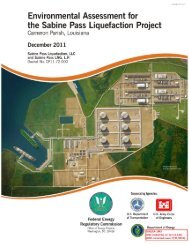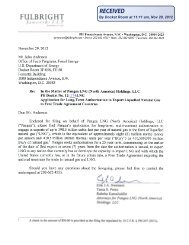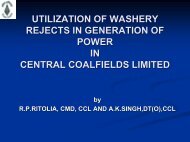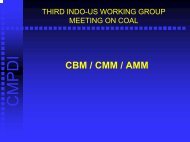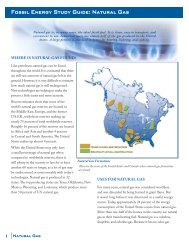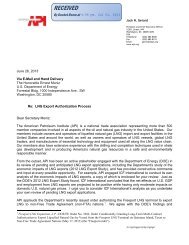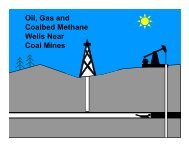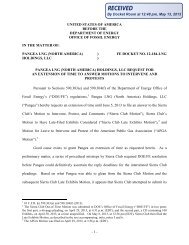Coal Combustion Waste Management at - DOE - Fossil Energy ...
Coal Combustion Waste Management at - DOE - Fossil Energy ...
Coal Combustion Waste Management at - DOE - Fossil Energy ...
Create successful ePaper yourself
Turn your PDF publications into a flip-book with our unique Google optimized e-Paper software.
52<br />
the surveyed units was conducted to identify the n<strong>at</strong>ure and extent of any variances to the<br />
regul<strong>at</strong>ory requirements. This section describes the findings associ<strong>at</strong>ed with the review of<br />
inform<strong>at</strong>ion in the CCW permits and follow-up interviews with utilities and St<strong>at</strong>es, where<br />
necessary, to ascertain the degree to which regul<strong>at</strong>ors are implementing St<strong>at</strong>e requirements as<br />
intended.<br />
3.3.1 Overview of Variance Requests<br />
The permit review found th<strong>at</strong> from 1994 to 2004, 52 variances were requested by<br />
oper<strong>at</strong>ors of new or recently expanded disposal units in 9 of the 16 St<strong>at</strong>es containing surveyed<br />
units: Florida, Georgia, Illinois, Indiana, Minnesota, Ohio, Virginia, West Virginia and<br />
Wisconsin. No variance requests were identified in the remaining seven St<strong>at</strong>es: Michigan,<br />
Missouri, North Carolina, North Dakota, New Hampshire, New Mexico, and Pennsylvania. The<br />
review also found th<strong>at</strong> few of these requests were rel<strong>at</strong>ed to liners or groundw<strong>at</strong>er monitoring.<br />
For example, only four variances to groundw<strong>at</strong>er-monitoring requirements were requested.<br />
While all four were granted, they applied only to organic constituents not found in CCWs.<br />
Similarly, only seven variances to liner requirements were requested. These were not to exempt<br />
the units from using liners, but r<strong>at</strong>her to allow the use of altern<strong>at</strong>ive construction methods or liner<br />
m<strong>at</strong>erials. Of the seven liner variance requests, two were rejected, three were granted with<br />
stipul<strong>at</strong>ions, and two were granted only after the protectiveness of the proposed altern<strong>at</strong>ives was<br />
demonstr<strong>at</strong>ed to the regul<strong>at</strong>ors. For one of the two liner requests granted, approval of a request to<br />
use an altern<strong>at</strong>ive (unconventional) method to consolid<strong>at</strong>e subgrade found<strong>at</strong>ion soils was granted<br />
after the success of the altern<strong>at</strong>ive approach was demonstr<strong>at</strong>ed <strong>at</strong> the specific site for which it<br />
was requested. In the second case, permeability d<strong>at</strong>a for an altern<strong>at</strong>ive liner m<strong>at</strong>erial (soil<br />
combined with compacted Poz-O-Tec) submitted by the company demonstr<strong>at</strong>ed th<strong>at</strong> the<br />
permeability of the combin<strong>at</strong>ion liner would be no gre<strong>at</strong>er than th<strong>at</strong> allowed for the 3-ft<br />
compacted soil liner specified in the regul<strong>at</strong>ions.<br />
The following paragraphs describe the overall review of the variances requested and the<br />
St<strong>at</strong>e agency responses; Section 3.3.2 describes specific variance requests. Appendix J<br />
summarizes variance requests by St<strong>at</strong>e and c<strong>at</strong>egory of requirement (e.g., liner, groundw<strong>at</strong>er<br />
protection standards); Appendix K provides, for each of the 52 variance requests, the variance<br />
c<strong>at</strong>egory, a description of the specific request, whether it was granted or not, a summary of the<br />
regul<strong>at</strong>ion to which the variance applies, the cit<strong>at</strong>ion of the regul<strong>at</strong>ion, and the host St<strong>at</strong>e of the<br />
unit for which the variance was requested; and Appendix L provides, for each variance request,<br />
the granting r<strong>at</strong>ionale (if granted), the revoc<strong>at</strong>ion provisions (if any), and any comments th<strong>at</strong><br />
further explain the variance.<br />
In their survey responses, oper<strong>at</strong>ors of surveyed units reported th<strong>at</strong> 11 units in 6 St<strong>at</strong>es<br />
had one or more variances in their permits. All were for landfills. Because the inform<strong>at</strong>ion in the<br />
survey responses lacked the detail needed to investig<strong>at</strong>e the variance issue thoroughly, we<br />
examined all 65 permits received from unit oper<strong>at</strong>ors (whether or not the associ<strong>at</strong>ed survey<br />
reported a variance) to determine whether variances had been requested and granted and, if so,<br />
the r<strong>at</strong>ionale behind the decision.



